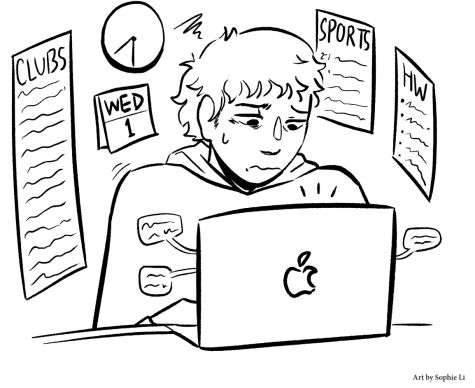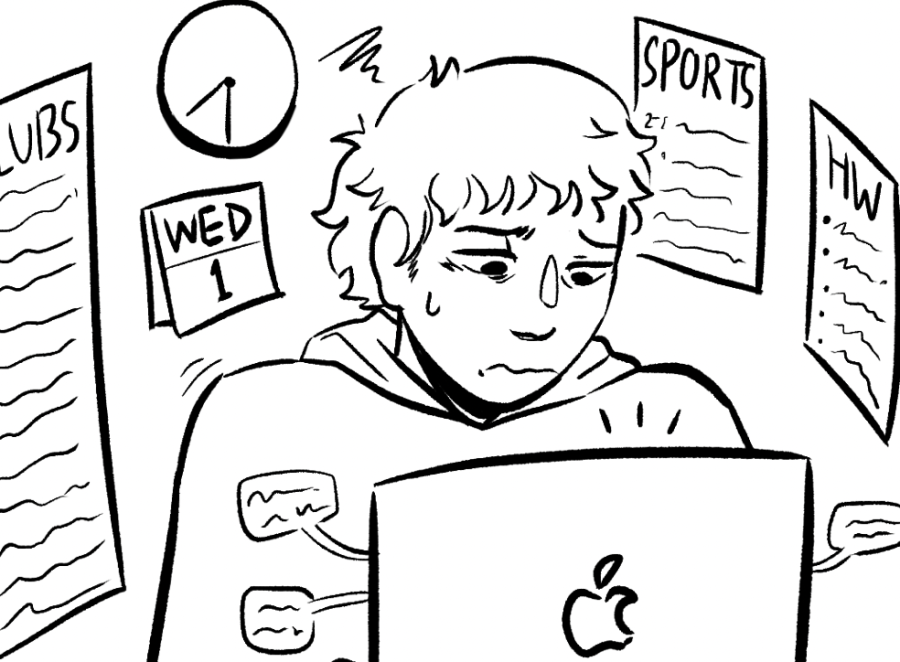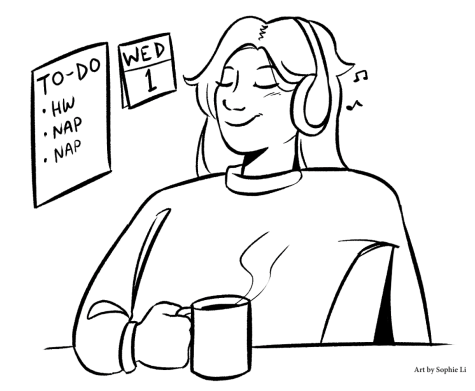Are Wednesdays here to stay?
May 4, 2021
Keep our day of relaxation
Students all over the Upper School wake at 8:10 a.m., refreshed and ready for the day. “I just slept in a full hour!” they exclaim. Off to class meetings, and then the day is up to them. Clearly, Wednesdays are the silver lining of our COVID-19 schedule.
We’ll break this down into the simplest terms possible: post-pandemic, this Wednesday schedule should stay because Wednesdays give us more freedom over our own time. Point blank. The observant reader may question this statement:
“Aren’t Wednesdays just a combination of the week’s X blocks?”
Wednesdays are more than that, too. We don’t, for instance, have to wake up before dawn or commute early in the morning—time better used to get some extra sleep.
Wednesdays are an open time to work on school assignments, including anything from daily homework to longer-term projects. Stressed in the classroom? Need more time to complete assignments? Wednesdays to the rescue! The free time allows students to slow down, reassess their work week, and prepare for Thursday and Friday. For those who desire, Wednesdays offer a great opportunity to catch up in certain classes, meet with teachers, or even get a jump on future assignments. For several students in Global Online Academy (GOA) courses, Wednesdays are a chance to collaborate with classmates in different time zones and do asynchronous work without it piling up on regular classes.
Apart from homework, Wednesdays also give students a break from a constantly controlled environment. For 24 hours, we can manage our own time without being told exactly where to go, in what way, at what time. And that has social and emotional benefits. By taking a day off from daily classroom activities, we give our brains and bodies a break. Instead of staring into computer screens or peering over our masks at whiteboards, we can nap, watch some TV, play sports…the list goes on. We can also meet with friends, enjoy family time, or devote ourselves to other extracurriculars. Wednesday flexibility allowed one of our editors to take on tutoring as a rewarding community service project. A junior pole vaulter we know can now pursue her passion beyond the weekend.
Wednesdays are like taking a breather in the middle of a sports game. Even the best athletes can’t run sprints for a straight hour; they would burn out or sustain an injury. We all know what happens then: they’re out for the season. Our brains need the same rest our bodies do—if students push themselves too hard, they fall apart. Wednesdays provide the much-needed time to hop on the sidelines of academic work, even for just a little while.
Yes, these benefits all depend on individual student situations with respect to clubs, arts, and sports involvement. For students wishing to maximize their participation across multiple clubs while also balancing performing arts or sports and reserving time to meet with teachers, Wednesdays can get real short, real fast. But this was a truth even during our pre-pandemic schedule, when multiple clubs would meet during Activities on the same day. And when we are back in person full-time, performing arts can return to regular weekday blocks, freeing up Wednesdays more.
No matter the schedule, there is simply never enough time to do everything offered at the school. We must remember that we are the ones choosing to attend different activities. On Wednesdays we have the power to make those choices, and it’s both a freedom and a responsibility that prepares us for college and beyond, when we must also prioritize our commitments.
The bottom line is this: although Wednesdays can cause some scheduling difficulties, we students can still access all the clubs, arts, and sports BB&N normally offers. We can still practice and develop our personal interests. The only difference is that the week is slightly reconfigured. But who’s to say reconfiguring is bad, if it gives us more time to rest, catch up, and organize our own time? Not us.
—Augustus Hawk, Maya Benjamin, Michelle Barrocas, Dylan Higgins, Mary Randolph (all ’22), Emmy Lev, and Madera Longstreet-Lipson (all ’23)
Settle our Wednesday frustrations
Students all over the Upper School groggily wake up and Zoom into grade meetings. Seeing none of our academic classes on Knight Life, we think, “It’s a weekend!” Sadly, not really. Grade meeting at 8:30, advisory at 9:00, clubs from 9:20 to 12:20, sports from 1 to 2:30, and 45 minutes of homework from every class since teachers know we have two days to do it. To top that all off, if you are one of us lucky Vanguard editors, you have an hour-long meeting at 6 p.m. Don’t get us wrong; the break from the cranking gears of online school is nice, but not at the cost of the week’s natural rhythm and all the X blocks we could enjoy balanced throughout the week.
Let’s start with the main issue on current Wednesdays: clubs. With only three blocks free for Wednesdays unlike the four X blocks and one Activities during last year’s schedule, many students have had to choose between two or more clubs they love. Medical Club during FEMCO, Speech and Debate during Model UN, Investment Club during Entrepreneurship Club—the conundrum is chaos, and many of us lament lost club opportunities.
These conflicts are especially prominent for students in performing arts. One of our editors, who leads the virtual Latin Club at 9:20 a.m. and plays in the orchestra at 10:20 a.m., must miss half of Latin Club to leave home and arrive in time to join other musicians at school. It’s nearly impossible for performing arts students like him to partake in clubs during both blocks.
Performing arts themselves have taken a huge hit with the new Wednesday schedule. Every art teacher we’ve talked to agrees that, barring public health exceptions, the old schedule with room for meetings on more than one day a week is preferable.
Once-a-week meetings slow down learning, with the beginning of performing arts’ practices invariably spent refreshing prior instruction. Arts like chorale or theater can be the only reason a student comes into school on Wednesday, so students with longer commutes and no adults to drive them must participate virtually, and students who use arts as academic or athletic credit must always attend and thus miss the chance to participate in most clubs.
Before this new schedule, X blocks were for meeting with teachers and advisors. Dissolving them all—or migrating them all to Wednesday—has diminished student opportunities to meet with teachers throughout the week and rendered lunch the only free time all faculty and students consistently share. Meanwhile, since classes must meet four times a week, students have all of their courses’ homework on Monday and Thursday nights, causing an unhealthy imbalance of relaxing Wednesdays and high-stress Mondays and Thursdays. The dizzy, unorganized week makes Tuesday nights feel like Fridays, which extinguishes much of the impulse to do homework. We know none of our work is due the next day, so even if we want to do all homework Tuesday, pushing it off to Wednesday is sometimes too hard to resist. Thursdays used to feel exciting, with three days of work behind and only two more days until the weekend; now they feel like Mondays, since we must snap out of “break” mode and return to the rhythm of school. We don’t get that build of a five-day work week that can make Thursdays far more welcome and Fridays so much more of a rewarding treat with a clear cutoff between work and repose.
If we have the choice, returning next year to a five-day academic week with X blocks would decrease our daily workload and stress, provide us ample time to meet with teachers, and keep our activities from interfering with each other. The weeks would once again “Zoom” by.
—David Min, Eli Waisburd, Saffron Patel, Sofia Chen (all ’22), Danielle Brennan, Ford Legg, Anjali Reddy, Rahdin Salehian, and Fatmata Sesay (all ’23)



